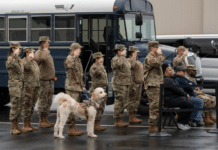By Karen Ross, CEO, Sharp Decisions
There is so much to be said about the vital role that veterans play in the civilian workforce. But can the skills they learn in the military translate to other career paths? Often, more work needs to be done to support the transitioning veterans and for this reason, underemployment has plagued veterans for decades.
At Sharp Decisions, our expertise is to identify and vet the most qualified veteran talent, and train and deploy them to our client companies across the country. In our nearly 30 years in business, we’ve noticed that veterans consistently offer an exceptional experience that is significantly under-represented in the corporate world. To better understand why, let’s look at what’s driving unemployment, the challenges veterans face, and what more companies should be doing to address it.
First, veteran unemployment figures only tell a partial story. The Bureau of Labor Statistics has reported that veteran unemployment hit an all-time low of 3.8% in 2018 – but this doesn’t account for vets who have given up looking for work, or the number of hours they work in a given week. In other words, whether they work full-time or just 10 hours a week, they are considered employed – regardless of whether or not they are using their skill sets or earning enough to provide for their families.
What’s perhaps more telling is that 44% of veterans leave their first post-military job within the first year (according to the George W. Bush Institute). The simple reason is they are not fulfilled and are often working in positions that are below their skill level. This contributes to a much deeper issue – veteran underemployment. The Call of Duty Endowment and Zip Recruiter estimate that the veteran underemployment rate is as high as 15.6%.
Additionally, there is a real issue of perception. If people who don’t expect to make a career out the military don’t think that their experience in the service will help them with their civilian lives when they transition out, they are much less likely to join. When a recruiter is looking to fill a job that requires 10 years of cyber experience for example, they are not going to consider a veteran who was in the service for 5 years and then in the workforce for 5 years. That veteran’s direct job experience in service is often overlooked when factoring in their total work experience, even if there are areas of significant overlap. This puts them at a huge disadvantage.
So, what could be contributing to this reality?
For one, the veteran to civilian transition programs offered by the government are limiting. Men and women in the armed forces should be building on the skills they have gained, but the government’s approach is more concerned with ensuring that they find employment – meaningful or not.
Spouse and family issues also play a huge role. While veteran underemployment is at least measured, spousal underemployment is addressed even less frequently. Spouses are forced to quit their jobs and move along with their husband or wife, which often forces them to find another job. The Blue Star Foundation estimated that the societal cost of unemployment and underemployment of military spouses is between $710M and $1.07B. There are real concerns not only for the vets themselves who are looking for employment, but for their families as well.
And consider that transitioning veterans are typically older than the usual entry level workforce candidate – meaning they have higher bills to pay and likely a family to provide for. Many of them are often forced to take jobs that are not the right fit due to financial obligations, only to then leave those positions because of dissatisfaction or it not being the right fit.
This creates a major responsibility for companies who have the means to do something about it. But there is unfortunately still a stigma to hiring veterans, which needs to be addressed.
At Sharp Decisions, we launched our V.E.T.S. program in 2013 because it was good business and a win for each party touched by the program. Treat veterans the way you would treat any new employee but position them for success. It is incumbent upon the employer to understand the value of a veteran and create job positions that all parties can benefit from. Typical programs that are geared towards helping veterans secure employment mostly focus on getting a vet a job, regardless of whether or not that job meets their experience or their goal for a meaningful career.
We need to work toward changing the perception about veterans’ capabilities. Human Resource representatives should not just focus on specific experience levels, they should factor in better ways to count veteran experience toward their overall contributions to the company.

About Author: Karen Ross is the president and CEO of Sharp Decisions, a global consulting and talent solutions firm based in New York. She founded the firm in 1990 under the premise that “anything is possible with teamwork and integrity.”
As a visionary entrepreneur, Karen has guided countless clients through decades of technological change. With seven offices in the U.S., one in Canada, and a European headquarters in London, Karen’s leadership of Sharp Decisions reflects her commitment to integrity and delivery. These values also gave her the impetus to start the V.E.T.S.™ program in 2013, which promotes meaningful employment for highly-skilled veterans. The V.E.T.S. model is the first of its kind in the nation.
Karen is a graduate of Union College. She and Sharp Decisions have been nationally recognized with a myriad of awards, including recognition from Crain’s New York Business and Inc. Magazine.
About Sharp Decisions: Sharp is a technical staffing and consulting firm that has a big veteran program and does a lot to combat issues if veteran unemployment and underemployment. Official Web Site: SharpDecisions.com
All content herein is owned by author exclusively. Expressed opinions are NOT necessarily the views of VNR, authors, affiliates, advertisers, sponsors, partners, technicians, or VT Network. Some content may be satirical in nature.
All images within are full responsibility of the author and NOT VNR.
Read Full Policy Notice - Comment Policy































